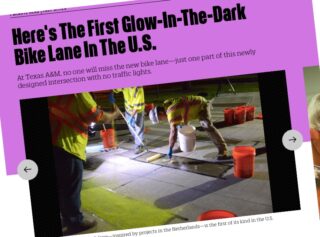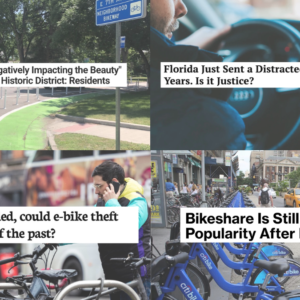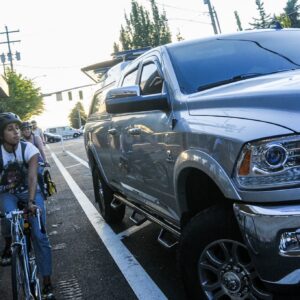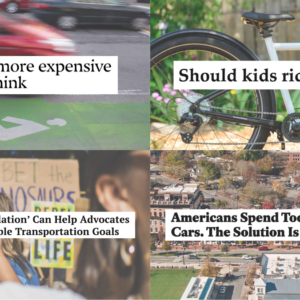This week’s Monday Roundup is sponsored by Bike Index, bike registration that works.
Welcome to a new week.
Doesn’t it feel good to finally have some clear and sunny skies? I saw tons of people enjoying the weather on their bikes over the weekend. I hope you were out there too.
Let’s start off by sharing the last week’s best stories from around the web and around the nation…
Gritter bike: The “world’s first gritter bike” is bouncing around the web. Wonder if they make a plow attachment too?
Powerful narrative: City Observatory shares how the narratives we tell ourselves about the future of our cities has vast influence.
Mile-High City in good hands: Denver’s mayor is making the right noises about transportation. Let’s hope he delivers.
More good news from Denver: Their legislature is considering a key update to vehicle law so that bicycle users are not required to come to a complete stop at stop signs and red lights under certain circumstances.
It glows!: An intersection on the campus of Texas A & M University uses several Dutch-inspired principles to protect bicycle users — including America’s first glow-in-the-dark pavement markings.
Florida gets protection: In other news from places that aren’t the usual bike-friendly suspects — Florida has announced its first protected bike lane project.
Advertisement
DC slowdown: Our nation’s capitol is moving forward on Vision Zero plans by lowering speed limits on residential streets to 20 mph and introducing “neighborhood slow zones” where that limit will go down to 15.
Don’t accomodate cars: An analysis of U.S. Census figures shows that even as Seattle grows, fewer people are driving alone and opting instead for transit, biking and walking.
Injustice: A judge in Chicago gave a very drunk, repeat-offender, reckless driver a mere 10 days in jail after he hit and killed a man who was riding his bicycle.
Taxpayer-funded driving privilege: A suburban county in Maryland spends over $100,000 in car allowances for its council members.
A bike education update: Streetsblog delves into a sacred topic in bike advocacy circles — bicycle safety education — and wonders if it might be time for an update to the conventional wisdom.
Gamified rebalancing: Citibike bike share in New York City has taken crowd-sourced rebalancing to a new level with their “Bike Angels” program.
China’s elevated bikeway: Five miles long and connected to transit stations, the new “cycleway in the air” connects several cities and commercial districts.
Thanks to everyone who flagged these stories for us.
Now let’s make some headlines of our own.
— Jonathan Maus: (503) 706-8804, @jonathan_maus on Twitter and jonathan@bikeportland.org
BikePortland is supported by the community (that means you!). Please become a subscriber or make a donation today.







Thanks for reading.
BikePortland has served this community with independent community journalism since 2005. We rely on subscriptions from readers like you to survive. Your financial support is vital in keeping this valuable resource alive and well.
Please subscribe today to strengthen and expand our work.
We obviously live in a city that likes grit in the bike lanes. They are full of it, 6 weeks or so after they dumped rocks everywhere.
I rode around Clark county this weekend. Clean streets, what a nice break from riding around in this so-called Bike city…
Seriously… the lanes on the main offramp from the Hawthorne Bridge coming into downtown still hasn’t been swept. C’mon PBOT! Please clean up your mess!
Whoever made the decision to dump this much gravel should be fired….
It did nothing during the snowstorm and has made life miserable for not only cyclists, but has been a huge boom to car windshield replacement companies.
It is a hazard and as much a safety issue for cyclists as anything else out there.
Just disgraceful.
And the Main St bike and turn lane at the end of the ramp between 1st an 2nd should now be considered ‘unimproved’ and a true hazard since getting beat up with chains. I think at least they should put up a warning sign indicating dangerous road condition, if they are not going to fix it.
That spot is a f-ing disaster. The block between First and Second looks like it has been carpet-bombed, and there is a new pothole on Second in the middle lane. IMO it should be PBOT’s top priority for downtown road improvements. I’ve brought this up to them a few times in presentations about the downtown multimodal project. Besides the quality of the pavement, that spot is a huge conflict zone between bikes, buses,m and right-turning motor traffic. What’s needed is a curb-tight protected bike lane coming off the Hawthorne with a floating bus stop and a separate signal for right-turning motor traffic with a no turn on red restriction.
Usually when we talk about sliding down a gravel hill into a rock garden, it’s a mnt bike trail. I was thinking that PBOT was testing out a new concept to get more off road cycling opertunities.
http://www.fixourstreetsportland.com/projects/
>SW Main from 1st to 2nd
A simple repave would be welcome but it needs to be coupled with bike-specific improvements. It’s absurd that the busiest bridge in the state for bikes drops you off downtown with virtually non-existent cycling infrastructure. That single block is ripe with conflict between buses, bikes, and cars — a simple fix would vastly improve the situation for everyone.
Yes, that spot is still awful, as are the green lanes on Caruthers near OMSI. PBOT appears to have given up on maintenance. Street lights on my block have been out for over three months now – yet PBOT says turnaround is two weeks. I say let’s get a few people together and sweep the damn lane ourselves.
I emailed PBOT a couple weeks ago and got a reply they were going to get them cleaned. Two weeks later and the same streets are full of rocks.
They have given up.
In other city news, the homeless camps appear to be flourishing again around a lot of bike routes…
New Mayor Ted looking good….
>In other city news, the homeless camps appear to be flourishing again around a lot of bike routes…
They’re blocking the whole sidewalk on the south side of NE Oregon st under I5 by the steel bridge again.
It’s not much, but on the “good news” front, it looks like the bike lanes on Willamette Blvd. along the bluff were swept in the past few days.
I like visiting Seattle, especially with a bike in hand. A work supervisor–45 years ago!!–had lived there and told me it was an absolutely terrible city to drive in, a perfect example of geography constricting road building.
PS–Prince George County’s council members sound like perfectly horrible drivers. They’d save money buying them some good bikes. Velo Orange is near there–maybe they could get a fleet deal?
I find it interesting that Washington D.C. is taking it’s 28 fatalities in 2016 far more seriously than we appear to be taking our 44 (or so) fatalities from the same year.
I’d like to propose that any street in Portland with uncontrolled pedestrian crossings for three or more consecutive blocks be reclassified as a maximum 25 mph zone. By “uncontrolled,” I mean the absence of stop signs or lights. I do not consider the self-control that requires drivers to “stop if pedestrians are present” to be an adequate form of control. Yes, I realize this would affect nearly every surface street outside of downtown. I’d like to say 20 mph, but I doubt it would sell.
Stph
In all fairness, the gritter bike appears to be designed to dump salt which would be way more welcome than gravel. But 50 lbs is nothing and I can’t imagine that being an effective way to deploy the stuff, particularly on slopes where it’s most needed.
The elevated bike lane looks intriguing, though I’d personally rather that transit were elevated in the hopes it could move faster, safer, and more reliably. The average person has a 7 mile commute. For most people, that works out to over an hour each way unless their start and end points are along the Banfield, the Sunset, or an area where stops are spread out and movement is quick. If we want people taking something other than cars, they need a reliable option where you’re not packed in like sardines in something that takes forever.
I was hoping it was made for salt… But “grit” refers to gravel not salt if I’m not mistaken. But yes, you are right in that there’s no reason it couldn’t lay down salt or some other de-icer product.
thanks john. i’ll edit the article to reflect that. (and will promise to read more and more carefully in the future).
Salt on roads is terrible…corrosive, environmentally bad…Oregon shouldn’t increase the use of it on roads. Even though it’s a flat hazard for biking, gravel is much better. Gravel from the main lanes of roads and streets, cast onto bike lanes by motor vehicle tires, is mong the most solid rationales for people traveling by bike to use the main lanes of the road instead of bike lanes.
There may well be no better way to get the point across to city and transportation dept’s that the bike lanes must be promptly swept of cast off gravel…then a major increase following ice and snow storms, in the use of main lanes of the road by people riding bikes, instead of their using the bike lanes.
The issue with grit is that its utility is limited with bikes even though I seek it out on slopes when snowy or icy. Ice with bicycles is extremely dangerous, and we get it often in PDX. I have personally witnessed many hard accidents, particularly in the vicinity of bridges.
There are environmental issues with salt and excessive use of the stuff is definitely bad. But all things should be examined on a cost/benefit basis. Roads, walkways, etc have a major negative impact on the environment and the city itself is a major source of pollutants. I think it’s way more dangerous than it should be to get around when it’s slick.
Vancouver has been having good results using brine. It’s a very thing layer but enough to melt frost and ice. When it washes away it isn’t much of a pollutant. (Then again it’s just going in the ocean.)
The usual road salt works by having the weight of passing motor vehicles crush it up into powder but that won’t work with bikes.
Well…over these past ten weeks, we had two big snow storms with a lot of snow. I don’t know if salt can improve traction on, or melt 8″-12″ of compacted, icy snow. Maybe someone else has experience and knows about this.
We also had, I believe a couple ice storms…not much accumulation, just slippery. Maybe the city could have tried salt instead if it knew for certain there was going to be no snow.
On some roads, one alternative to salt the city has been experimenting with, is magnesium chloride. The O recently did a story about it, compared to salt (I’m sure I read an O story that was more extensive than the one for which I’ve provided the link below, but I don’t seem to find it.). Somewhat better, but not wonderful, it seems. I think the city is limited in what it can do. Salt is terrible, but maybe the alternative substance being tried, isn’t so good either.
http://www.oregonlive.com/weather/index.ssf/2017/01/portland_test_finds_road_salt.html
I know about the bad corrosive effects of salt, in part…and about this, readers here may not be very appreciative…through reading a vintage car weblog. Model A’s. Lots of hobbyists live east of the Mississippi, mid-east and the east coast where it’s cold and salt on roads has been in use for many years. Knowledge of the corrosive effect of salted roads on motor vehicle steel is well known. Because of it, most don’t drive their vintage cars in winter. Lots of rust-out known of in modern vehicles subject to the salt. It’s very corrosive.
Aluminum bike components and people riding bikes would be subject to the corrosive effects of salt too. Different from how steel is affected, but definitely would have effects. Even with fenders, when whatever melt producing material is applied to the slippery stuff on the pavement melts it and turns it to liquid, that stuff will be thrown up by vehicle tires…everywhere…clothes, people’s skin.
Gravel is a crash (sliding potential) hazard as well as a tire puncturing and auto glass hazard. Funny that Oregon won’t salt roads but lets people drive with studded tires!
Salt isn’t all good or all bad. There is no single best option. Depending on the temperature, depth and changing conditions, the appropriate treatment may be rock salt, brine, other deicers like MgCl, sand or a combination.
You might fret that salt is “environmentally bad,” and here in Minnesota (which probably uses tens of thousands of times more salt than Oregon ever will) there are concerns. But there are also major problems with sand: the resulting dust generates significant air quality problems, and the runoff silts up sensitive streams and wetlands. So although our climate dictates that we use a lot of salt, sand and other treatments, they’re actually quite careful about exactly how much of anything they put it down and under what conditions.
Our roads in Minnesota get pretty gritty by the end of winter, but Portland’s are actually worse for cyclists right now. One reason is that road agencies are pretty judicious about how much sand they spread.
The other reason is Minnesota uses actual sand, not the pea gravel Portland and Washington County have used this year. What’s unacceptable is not that Portland hasn’t cleaned it up – arguably they should NOT waste money doing so until winter is really over – but what they put down in the first place.
“…The other reason is Minnesota uses actual sand, not the pea gravel Portland and Washington County have used this year. …” glowboy
The type of gravel I’ve always seen used out west of Portland, in Beaverton and Washington, isn’t pea gravel…the small, round, river washed pebbles…it’s instead, irregularly shaped small rocks with sharp edges that can grip into the ice under weight from large tires invulnerable to puncture from the rocks.
It’s hard enough to walk on the gritty bits of gravel laid down. Round gravel would be worse to walk on, but then, it wouldn’t be the problem for punctures to lightweight bike tires that gritty gravel is.
One of the worst outcomes, is when faced with a snow or ice forecast, the road depts go out the night before and lay down a bunch of gravel, only to have the slippery stuff melt right away, the next day.When the forecast is for warming, soon following the snow and ice of the night before or the morning commute, if people could just be persuaded to sit it out at home for a day, that could possibly eliminate the need to apply any traction material to the road.
Maybe the second, heavier of the two snow storms of this year, hit on a weekend. Can’t remember. Do remember in the morning though, how vacant the streets out in the beav were. Not much traffic for the entire day. Second day, some traffic, but nothing like a usual day. Once the snow was packed down on the third day, and more people had their traction device thing figured out, traffic picked up a lot.
Reading the DC article, reminded me that one missing piece of the speed zone puzzle…now that residential streets can be 20 mph…is that school zone minimum speeds are often still 20 mph in the northwest (historic legacy)…vs. 15 mph in the many of the NE states (and CA).
In urban areas in the NW – after a traffic study – our communities should have the opportunity to lower the minimum speeds in school zones to 15 mph, as these are some of the most chaotic and dangerous (youth / vulnerable populations) and yet pedestrian rich areas (high foot traffic)…as part of the VZ push to update our traffic laws.
And yet we have 35 MPH+ heavy traffic less than 50 foot from Cleveland High school + others.
I bet if you recorded speeds there over a 24-hour period you’d probably catch some people doing 55-60. We’ve started recording speeds in our neighborhood that way, and found one driver going 47mph through our neighborhood in front of the elementary school, at 8pm. And there is a speed display sign there too!
…and they carry the speeding from Powell right on over to SE 26th on the west side of Cleveland H.S.
Desperately need something to break up that long no-stop stretch on SE 26th between Powell & Clinton. It just screams “SPEED NOW!!!” as is. Can’t believe how fast even heavy trucks feel comfy going on 26th now. They don’t even fit in the lanes.
p.s…how are you clocking speeders, Dan A?
Speed display sign with a lockbox and a laptop. I don’t mean to take any credit for the work — our HOA is tracking it and providing me with the data.
The HOA arranged for the speed display sign, I assume? Or can just anybody go get one? Would dearly love to have one or more of those on SE 26th, grrr. I hate drivers here more by the minute.
I think we own two of them.
“…We’ve started recording speeds in our neighborhood that way, and found one driver going 47mph through our neighborhood in front of the elementary school, at 8pm. …” dan a
At that school zone, is the 20mph posted speed limit (not sure, but think that’s the mph speed limit for school zones.) in effect all hours of the day? Or is it one of those school zones equipped with a sign and maybe a flashing light as well, that requires the 20mph limit be maintained only during certain hours?
I’m thinking of the school zone adjacent to Beaver Acres grade school on 170th just south of the intersection with Merlo Rd in Beaverton; it has such a sign as I’ve somewhat accurately described.
47mph sounds high, though I don’t know the speed limit in general, of the road to which you’re referring. If it were posted, for example, for 40mph, as 170th is…47 would be excessive.
It’s 20mph until 5pm, and then 25mph. It’s a neighborhood street.
more accurately, school zones are maximum 20 mph.
Hey Jonathan- Saw you out snapping photos of the Gateway Green build party. I can’t believe the amazing weather we got, the weather gods were truly smiling on that event. Being out there working on the trails got me even more excited than before for what’s to come.
me too! Story coming before noon. stay tuned.
The streetsblog article, expressing an opinion on biking education:
http://usa.streetsblog.org/2017/02/07/bicycling-education-in-the-united-states-needs-an-update/
…didn’t to me, and apparently some other people seem very well thought out, but it did spark a very solid, well thought out discussion in that story’s comment section. While I’ve yet to read all 78 of the comments that had been posted upon starting to read them, the 20 or so most recent of them seemed to be studied opinions based on first hand riding experience.
Generally, my own thoughts about biking education, is that most people that feel they’re going to be needing or wanting to ride in traffic that includes motor vehicles…can benefit immensely from good education in biking in that traffic environment, safely and efficiently.
I suppose by and large, most people get their biking education ‘seat of the pants’. This has been the way, forever, it seems…and maybe that’s the way education in biking well, will continue to be acquired by people, for who knows how long.
I think one of the biggest downsides to continuing to have people learning biking education skills and procedures by this method, rather than solid, course instruction by people with experience in riding, is that maybe a lot of people get overly scared and intimidated by their exposure to motor vehicle traffic as they struggle to pick up all on their own, the basics of biking in traffic. Then they come to feel that ‘no way no how’, can they ride reasonably safely on the lanes…including bike lanes directly adjoining main lanes….of any road with a lot of motor vehicle traffic. End result: they don’t ride..or if they do…a very limited amount.
For those who argue that biking is only for the young…
https://www.nytimes.com/2017/02/08/well/move/lessons-on-aging-well-from-a-105-year-old-cyclist.html?_r=0
It’s how the late great street fashion photographer Bill Cunningham got around, too!
https://www.nytimes.com/video/fashion/100000001032512/bill-cunningham–cycles.html
Also mentioned in the DC article, of utmost timeliness:
“DDOT’s plan also requires side guards be installed on all large commercial vehicles in the District.”
Wow!
I try not to ride sidewalks, but coming up Johnson Creek Blvd from Bell Station to 82nd there was little choice.
Only other way to avoid the gravel was to ride far left in the bike lane, almost on the line.
That’d be all I need …get clipped in the back by somebody’s right mirror 🙁
Hancock(Denver) is king of the smoke screen say the right things to the right people, put up one project and then disappears. Let’s not forget the i70 ditch which is a massive increase highway capacity through the heart of a neighborhood with zero real bike or walking capacity. Crappy sidewalks notwithstanding
Denver has multiple one way streets three lanes wide…..A relic from the 50s..Even today. Denver could easily put in real protected lanes almost downtown wide with minimal work. But they dont
Where’s the outrage at a 10 day sentence for killing a bicyclist while driving twice the posted speed, and nearly twice the BAC allowed? That judge should be recalled immediately, and while we can’t prosecute the driver for a second time, if he even thinks about getting behind the wheel toss him in the clink, and lose the key.
Horrible story. I kept wondering if the judge is a drunk himself.
You’re not advocating a protected lane down to 2nd are you? Because a lot of us have to merge with traffic and get over to the left lane in just a short span coming off the Hawthorne to get onto 1st, and any barrier there would be a disaster.
In my mind, the protected lane would only be between First and Second Avenues. Although, I can’t imagine merging across two traffic lanes on the short off-ramp is comfortable anyway, so maybe there’s something that could be done to improve that movement as well. Perhaps some sort of protected two stage turn at First and Main?
I used to ride that particular merge onto First every weekday. As far as comfort goes, there’s no issue at all so long as you match traffic speeds which is pretty easy since that’s in a downhill area and the cars never move that fast. It would not be fun to do slowly unless traffic was all gummed up.